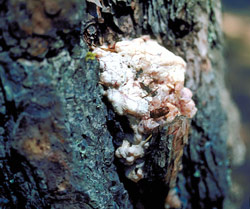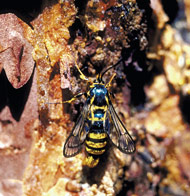|

Sequoia Pitch Moth’s feeding injury causes the tree to produce copious amounts of unsightly resin Sequoia Pitch MothDownload a PDF of this articleDescriptionThe SPM adult is a clear winged moth that mimics a yellow jacket to protect it from predators, however, it cannot sting. Larval infestations are recognizable by pinkish pitch masses that protrude from infested trunks and limbs (see photo). As the larvae feed and grow beneath the mass, the mass enlarges and hardens, becoming a darker gray. Old pitch masses can remain on the bark for several years. Plants AffectedSPM can infest many conifer species but mainly they attack pines such as Japanese Black, Ponderosa and Shore pine. Despite the name they do not infest Sequoia trees. Symptoms/DamageDamage from SPM occurs primarily from the larvae feeding under the bark in the cambium layer. Their feeding injury causes the tree to produce copious amounts of unsightly resin. This insect rarely kills the trees, however; limbs may be weakened or killed. Life CycleAdult moths emerge in mid summer and lay eggs on the bark, usually in crevices around pruning wounds and other injury sites. Larvae hatch and enter the injury site where they feed in the inner bark for the next two years. ManagementTreatmentApplication of a long lasting insecticide before moths fly in the summer can prevent new infestations CulturalCareful removal of the pitch masses and removal of the larvae within should be done during the dormant season SPM mainly attacks damaged trees, either from pruning wounds, storm damage or other mechanical injury, such as staking or weed eaters. To avoid an infestation it is best only to prune infested trees during the dormant season. Watering, mulching and fertilizing are important cultural practices to reduce the impact of infestation. |

The Sequoia Pitch Moth resembles a yellow jacket |
|
Home |
Services |
The Arbor Advisor |
Garden Calendar |
About Us |
Fact Sheets |
Contact Us |
Site Map Collier Arbor Care Portland 503-722-7267 Vancouver (360) 693-6056 Site contents and design ©2013 Collier Arbor Care |





